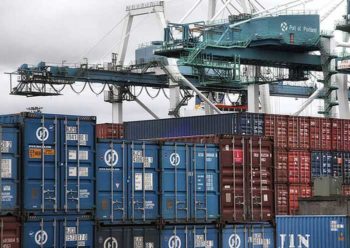
The Port of Portland has officially regained control of its container terminal, but agricultural exporters can’t expect shipping from the facility to resume quickly.
The port’s commission voted unanimously March 8 to sever ties with ICTSI Oregon, a terminal operator involved in a long-running labor dispute that brought container shipping at Terminal 6 to a halt.
“This gives us the opportunity to press reset,” Keith Leavitt, Port of Portland’s chief commercial officer, told the commission.
With ICTSI out of the picture, the port will now seek to repair relations with the International Longshore Workers Union, said Leavitt.
While that partnership is key to resuming service at Terminal 6, finding a new company to run the facility is more complicated, he said.
“How do you proposition when you have no cargo and no volume?” Leavitt said. “The value proposition to an operator is a complex equation.”
The port will need to identify its market strengths and develop a business plan for reactivating the container terminal, he said.
“We want to take the time to study what our future in the container business is,” Leavitt said.
The port expects to “hit the ground running with a new strategy” in early 2018 after conferring with shippers and other stakeholders, he said.
The undertaking comes at a time of upheaval in the shipping industry, adding another layer of difficulty to the situation, he said.
“We have to find our market niche. It’s changing and it’s more narrow than it’s ever been,” Leavitt said.
Getting the container terminal up and running will only be part of the solution for agricultural shippers, he said.
Even at full capacity, Terminal 6 was only serving about 55-60 percent of the potential regional market of importers and exporters, Leavitt said.
In the future, the port will need to take a comprehensive approach by helping shippers get products to ocean carriers in the Puget Sound as well as restarting its own terminal, he said.
One idea could be to send containers to ports in Seattle and Tacoma on barges, though the economic viability of this concept is questionable due to the added travel time involved, he said.
Terminal 6 also has a rail yard that’s been underutilized, Leavitt said. “We’ve never really consistently activated it.”
It’s not an option for the port to operate the terminal because that has proven unprofitable in the past, said Bill Wyatt, the port’s executive director.
“We were losing boatloads of money in the course of that,” Wyatt said. “We were subsidizing the operation of Terminal 6 by selling land and we were running out of land.”
This unsustainable position led the port to lease its container terminal to ICTSI for 25 years in 2011.
While the arrangement initially seemed productive, a dispute broke out in 2012 over whether the ILWU had jurisdiction over plugging in and unplugging refrigerated containers.
Since then, ICTSI has been locked in a labor battle with the longshoremen’s union that has involved several lawsuits.
The conflict resulted in slowed productivity that prompted ocean carriers to abandon Terminal 6 in 2015 and 2016.
“It could take a few years before there is light at the end of the litigation tunnel,” said Leavitt.
Now that ICTSI has agreed to amicably end the contract, the Port of Portland is once again free to decide what to do with the container facility, Wyatt said.
“It’s been a journey,” he said. “Maybe a saga is the best way to characterize it.”